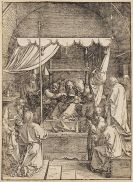
Albrecht Dürer
1471 Nürnberg
1528 Nürnberg
Albrecht Dürer, the most famous representative of German Renaissance, was born in Nuremberg in 1471. His father was a goldsmith and took care of the young Albrecht Dürer's first training in this field. In 1486 Albrecht Dürer changed to the painting workshop of Michael Wolgemut, where he completed an apprenticeship until 1490.
Albrecht Dürer was a prolific artist, making no less than 70 paintings , 900 drawings and 350 woodcuts and 100 engravings in his early period of creation alone. Particularly noteworthy is the famous silver pencil drawing from 1484, with which Albrecht Dürer created a virtuoso self-portrait even before he began the painter's apprenticeship. Eventually the world famous Munich "Self-portrait in fur coat" (1500) occupied a key position among the self-portraits of Albrecht Dürer.
In 1494/95 Albrecht Dürer traveled to Italy. On this trip he created some of his famous landscape sketches in watercolor. At the end of the century he made the “Apocalypse“ as a woodcut cycle (1498), stirring and expressive prints, with which Albrecht Dürer also referenced position in the religious and political power struggles of his era.
Two other large woodcut series originate from the beginning of the new century: "The Great Passion" (1498-1510) and "The Life of the Virgin" (1501 /11). Both work complexes show how Albrecht Dürer dared to transform religious subject in a profane manner.
In 1520/21 Albrecht Dürer embarked on another journey, during which study sheets of a striking drama were made. Albrecht Dürer was increasingly active as portrait painter, and his psychologically deep portraits from the 1520s doubtlessly mark a heyday in his oeuvre.
A masterpiece of special quality and at the same time a reference to Albrecht Dürer's religious and political attitude are "Four Apostles" (1526). This monumental work, which Albrecht Dürer personally conveyed to the Nuremberg City Council, admonishes the people of Nuremberg to a lasting commitment to the Lutheran religion only a short time after they had been reformed.
Albrecht Dürer must be called nothing less than a universal genius. The diversity of his artistic work is accompanied by a great number of theoretical models and scientific considerations. A sheet such as "Melancolia" (1513/14), which counts among the so-called master engravings of Albrecht Dürer, shows the whole depth of his art.
In 1528 Albrecht Dürer died in his native city of Nuremberg.
Related artists: Aldegrever, Heinrich | Altendorfer, Albrecht | Baldung gen. Grien, Hans | Baumgartner, Johann Wolfgang | del Sarto, Andrea | Dix, Otto | Israëls, Jozef | Kauffmann, Angelica | Leistikow, Walter | Lorrain, Claude | Portielje, Edward Antoon | Rembrandt, Harmensz. van Rijn | Ringelnatz, Joachim | Schongauer, Martin | Spranger, Bartholomew | Toulouse-Lautrec, Henri de

Would you like to sell a work by Albrecht Dürer?
Infos for seller






